AI Phones Seek Revival with DeepSeek!
![]() 02/19 2025
02/19 2025
![]() 452
452
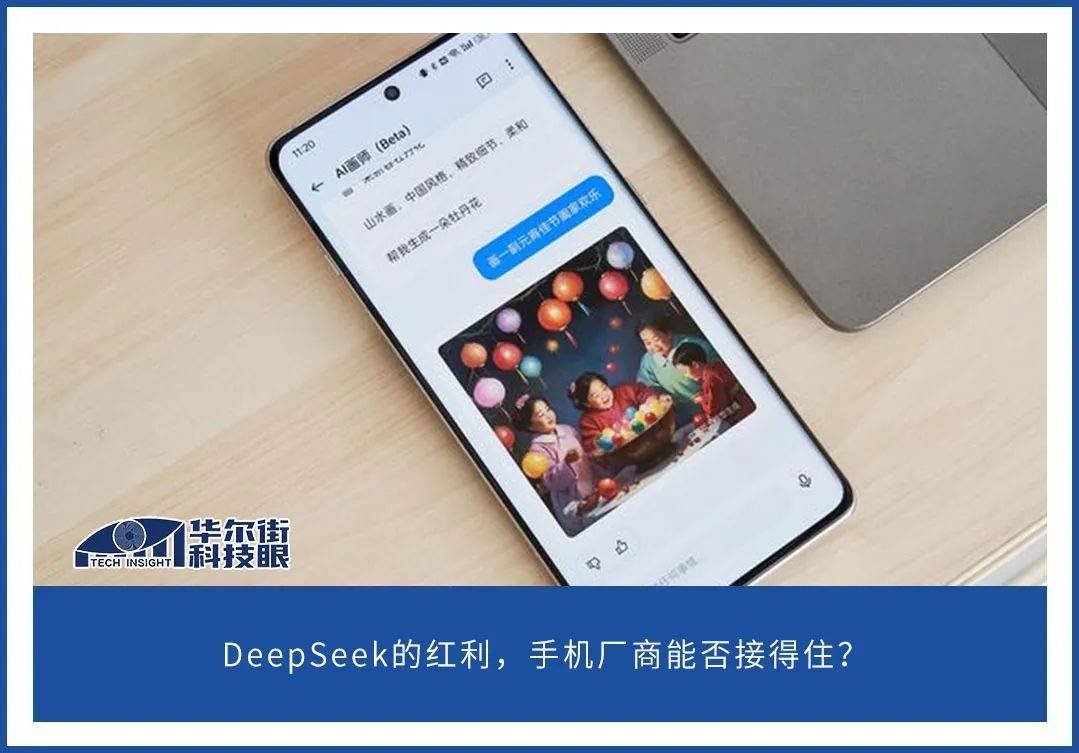
Text/Leon
Editor/cc Sun Congying
The ever-growing popularity of DeepSeek is now spreading across various domains, including smart terminals, autonomous driving, manufacturing, finance, and education. Among these, its application in the mobile phone sector has garnered the most attention.
Wall Street Tech Eye has learned that domestic brand Nubia will deeply integrate DeepSeek through a system-level embedded approach, enabling users to directly interact with the smart agent integrated with the DeepSeek large model while the phone screen is on, eliminating the need to switch applications. In contrast, Huawei's XiaoYi Assistant previously accessed DeepSeek, but it operated more like a plugin rather than a system-level integration.
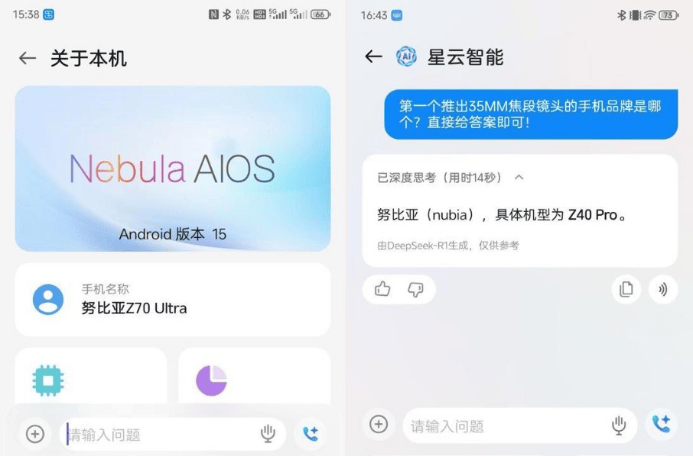
The advantage of the DeepSeek large model lies in its ability to achieve high-performance reasoning with lower training costs, and its open-source nature allows enterprises to customize it according to their specific needs. It is foreseeable that in 2025, more mobile phone manufacturers will collaborate with DeepSeek to bolster their competitiveness. (For details, see: "AI Godmother" Li Feifei Debunks Computational Myths, and DeepSeek's Algorithm and Costs Spark Controversy)
The concept of AI phones first emerged in 2024, with Samsung pioneering the way by introducing functions such as simultaneous interpretation and AI photo editing in the Galaxy S24. Subsequently, mainstream mobile phone manufacturers like Apple, Huawei, Honor, and Xiaomi launched their AI technologies, aiming to make them a driving force for users to upgrade their phones.
However, the harsh reality is that in 2024, global mobile phone sales reached 1.22 billion units, achieving only a 7% year-on-year growth, and AI did not significantly boost sales. Can mobile phone manufacturers reignite consumers' desire to purchase AI phones under the new wave of DeepSeek?
What Constitutes a "True AI Phone"?
Broadly speaking, an "AI phone" refers to a mobile phone that accesses an AI large model, enabling more intelligent operations compared to traditional smartphones.
Taking the commonly used AI photo editing as an example, in a photo, unnecessary people or scenery can be erased seamlessly. The principle behind this is to generate a similar background using the AI large model for filling.

Although there are no clear industry standards yet, we can dissect the composition of AI phones into two parts: hardware and large models.
In terms of hardware, high-end models like the iPhone 16 Pro series are equipped with the A18 Pro SoC, which integrates a 16-core NPU (Neural Processing Unit) capable of up to 35 trillion operations per second, significantly enhancing the efficiency of AI tasks. This part can be simply understood as "local computing power." Mid- and low-end phones usually have poor performance or do not carry NPU, which is why models below the iPhone 15 Pro cannot support Apple's intelligence.
In terms of large models, mobile phone manufacturers typically train their own large models while pairing them with general large models like DeepSeek to achieve better performance. Taking Apple as an example, iOS 18 locally deploys a low-latency LLM (Large Language Model) with 3 billion parameters, while also accessing Apple's private cloud computing's large cloud model and Open AI's ChatGPT, allowing users to use GPT to replace Siri and enhance the intelligent experience.
In summary, the true AI phones currently on the market need to meet the two essential conditions of being equipped with hardware NPU and deploying large local and cloud models at the system level. After all, most iPhones and Android phones can download AI dialogue applications like DeepSeek or Tongyi, but not all of them can be termed as AI phones.
Having clarified the true form of AI phones, the next step is to discuss what AI phones can actually do, which also explains the current dilemma of AI phones.
Current Situation of AI Phones: Average Experience, Consumers are Hesitant
As far as the models currently on the market are concerned, photo editing, drawing, Q&A, and executing simple operations (such as setting alarms, schedules, etc.) are the common application forms of AI phones, which have not seen significant improvements compared to the smart assistant era. Leading manufacturers are, however, seeking more advanced solutions to truly implement AI.
Taking Apple's intelligence as an example, it integrates a context association function, seeking to change the application form of AI from passive to active. One of the active AI functions is to summarize a series of content pushed by mobile apps through AI, allowing users to efficiently receive content. However, this ended up as a source of amusement rather than utility.
After the function was launched, users found that BBC news pushes were misinterpreted by Apple's intelligence. For instance, BBC reported that darts player Luke Little won the PDC World Championships semifinals, but Apple's intelligence misunderstood it as Little having already won the finals. Similar situations also occurred in news apps such as The New York Times and The Guardian.

Image: Apple's intelligence missummarizes news briefs
In response, an Apple spokesperson said that Apple's intelligence is still in the testing phase and will continue to improve based on user feedback, and that updates will be rolled out in the future to more clearly show that push summary content is generated by AI. Guardian Editor-in-Chief Alan Rusbridger did not accept this response and publicly called on Apple to withdraw this immature product.
Wall Street Tech Eye interviewed several ordinary consumers regarding the use of AI phones. Mr. Li, in his early 30s and working in the internet industry, has a good understanding of mobile phone products. He currently uses the iPhone 15 Pro but has no plans to upgrade because the Chinese version of Apple's intelligence has not yet been released. Even if the Chinese version of Apple's intelligence is launched in April this year as rumored, Mr. Li does not plan to upgrade to a new Apple phone because the overall changes are not significant.
Ms. Wu, 24, has been working for more than two years and requires a fashionable phone with good photo-taking capabilities. She chose the Huawei P70, and the mobile phone function she uses most daily is taking and editing photos. She believes Huawei's AI photo editing is very useful and occasionally uses XiaoYi Assistant to search for content, but she mainly chose the P70 for its design and photo-taking performance.
Ms. Wang, 57, uses an iPhone 13 handed down by her child. Besides watching short videos, shopping, and using WeChat, she basically does not use other phone functions. After explaining the relevant functions of AI phones to her, Ms. Wang believes that elderly people do not need them and will not replace their phones because of AI.
Let's take a look at the views of ordinary netizens. On Zhihu, there is a discussion titled "How do you view mobile phone manufacturers' bets on AI? What do you think about the saying that '2024 is the first year of AI phones'?" Netizens' opinions focus on "AI is artificial stupidity," "taking advantage of customers," "AI still needs many years of development," etc. Some technically knowledgeable netizens also questioned the local computing power and edge model capabilities of mobile phones.
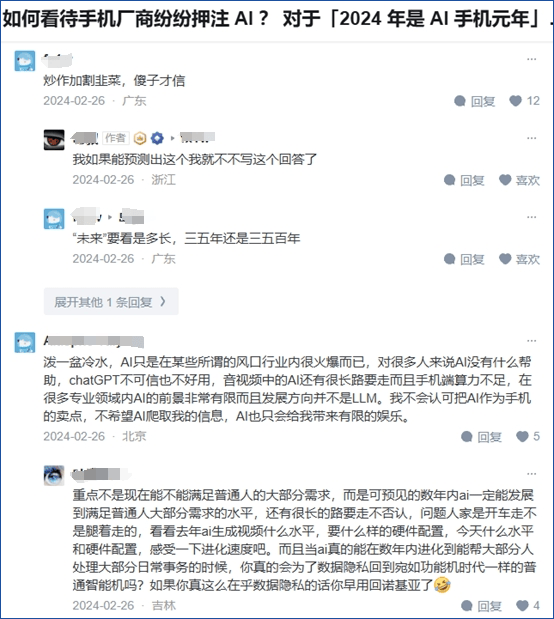
From a market perspective, leading mobile phone manufacturers have not benefited from AI. According to Apple's report for the first fiscal quarter of 2025 (October to December 2024), although its revenue reached $124.3 billion, the net sales of the iPhone product line were $69.14 billion, lower than market expectations of $71.03 billion and $69.7 billion in the same period last year, with sales declining by nearly 1 million units year-on-year. The Wall Street Journal commented that Apple needs more time to refine its AI capabilities, and investors' expectations for AI to drive iPhone sales have decreased.
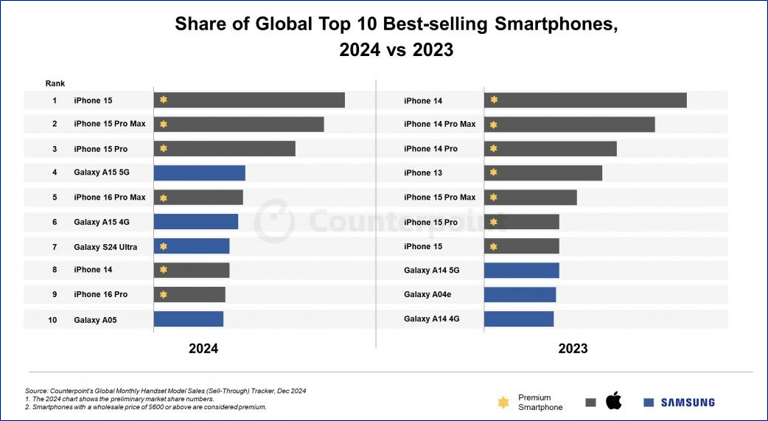
Third-party data also confirms the above viewpoint. Counterpoint data shows that the best-selling mobile phone model globally in 2024 was the iPhone 15, not an AI phone; the sales of the iPhone 14 also exceeded those of the iPhone 16 Pro, and three low-priced Samsung phones were also on the list. Combining netizens' opinions and market data, it can be concluded that the primary demand of consumers for upgrading their phones is still traditional iterations rather than AI.
Besides the unsatisfactory user experience, data security has always been a controversial point for AI phones, with tech tycoons like Musk expressing concerns about data security.
AI Phones Spark Controversy, Zhou Hongyi Exclaims "Dangerous"
After the release of Apple's intelligence, Musk pointed out that he prohibits employees of his company from using iPhone models that support Apple's intelligence due to concerns about data abuse. Apple emphasized that only data directly related to tasks would be sent to the cloud and would not be stored, and that verifiable privacy mechanisms would ensure security. In other words, Open AI would not directly see the privacy data of iPhone users. However, Musk does not seem to agree with this explanation.
Another typical case is Honor mobile phones. On the eve of the release of the Honor Magic7 series, former Honor CEO Zhao Ming participated in an internet program hosted by 360 founder Zhou Hongyi, discussing AI's reconstruction of smartphones. During the program, Zhao Ming used the AI function of the new Honor phone to order coffee, and the system directly took over the phone, simulating the user's fingers tapping on the screen to open Meituan takeout and start ordering, without the need for manual intervention.
The host asked Zhou Hongyi, "Mr. Zhou, do you think this function is amazing?" "Amazing, but dangerous," Zhou Hongyi replied. Zhou Hongyi pointed out that similar functions can only be done by mobile phone manufacturers because they are system-level, and the Meituan app does not know that an AI is simulating human finger operations. Zhao Ming only evaded this with the sentence, "For security in the AI era, we believe that privacy and security are above all else."
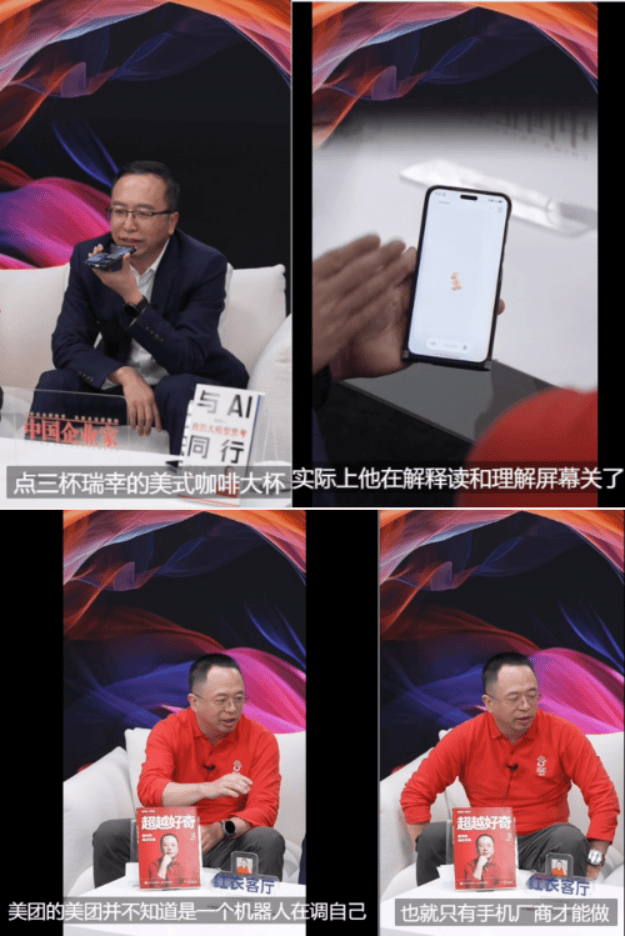
In fact, the operation of ordering coffee using Honor phones is an open secret in the industry. A research report from an authoritative securities trader pointed out that the current technical routes for AI phones to call third-party apps are mainly divided into two types: the first is cooperation between mobile phone manufacturers and app developers to access APIs in a legal form, such as Apple and Huawei, to achieve system-level calls; the second is a pure vision solution that does not require app developers' consent, directly invoking the Android system's accessibility permissions to read and understand screen content and simulate human clicks. It should be noted that accessibility permissions (Accessibility API) are special interfaces set up by Google for people with disabilities, close to the highest permissions of the Android system. Once invoked, it is equivalent to opening the door to the phone, leaving user data completely insecure.
So, why don't mobile phone manufacturers choose to cooperate with app developers and go through official channels? Firstly, cooperation is a lengthy negotiation process that requires win-win conditions; secondly, internet giants like Alibaba and Tencent also have their own considerations and needs for security and data sharing and will not rashly open permissions for Alipay and WeChat. In this case, some mobile phone manufacturers seeking to "overtake on the AI curve" will naturally tend to choose the convenient but aggressive method of invoking accessibility interfaces.
Can DeepSeek Boost AI Phone Sales?
As a leading global large model, DeepSeek has indeed brought some new focus to the mobile phone industry. For example, Apple CEO Tim Cook sang high praise for DeepSeek's innovation, leading to speculation that the Chinese version of Apple's intelligence might integrate the DeepSeek large model to enhance reasoning performance.
However, whether DeepSeek is a "savior" or a bubble-like trend has little to do with itself; the decider is the mobile phone manufacturers.
If DeepSeek is only used as a plugin or a locally deployed large model, it can indeed provide a more accurate Q&A experience, but that's about it. Essentially, it is not much different from installing a DeepSeek app on an ordinary phone.
To achieve system-level AI operations, cooperation with app manufacturers is needed to connect third-party data and some permissions, forming an AI ecosystem, which is a time-consuming and costly project. It is certain that leading manufacturers such as Samsung, Apple, and Huawei will invest huge resources to achieve this goal, but it will take time.
At the same time, the entire mobile phone industry also needs to wait for further maturity of global technologies, such as hardware computing power. Currently, deploying the DeepSeek large model on local PCs has certain graphics card computing power requirements. For example, the 7B-8B parameter version requires at least a mainstream graphics card with a minimum of 6GB of video memory, such as the RTX 4060/4070, which the Apple A18 SoC cannot meet. Although the local models running on mobile phones are usually customized, the physical laws of computing power cannot be arbitrarily broken. To better run large models, mobile phone hardware will inevitably need to be upgraded.
It is certain that AI hardware, including AI phones, will continue to evolve and iterate, but breaking through physical laws is temporarily unachievable. For enterprises, especially domestic mobile phone manufacturers, the easier trend to seize is the 2025 national subsidy, aiming to compete in both the ultra-high-end market and the mid-to-high-end market below 5,000 yuan, to have a chance to survive in the increasingly competitive smartphone market.
For consumers, the decision to purchase a mobile phone should primarily hinge on personal needs. Much like current AI assistants, these devices can indeed facilitate search tasks and assist in creating charts and tables, but they still struggle to produce a logically coherent and comprehensive manuscript. More often than not, they merely generate impersonal summaries. Similarly, AI-enhanced phones require more time to evolve into their ideal form, and there is currently no urgent need to pay a premium for AI capabilities.





